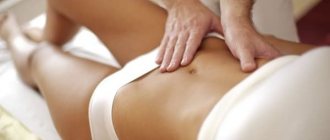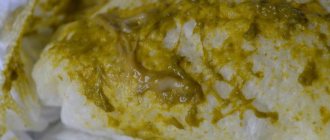Technique
Before the massage, preliminary preparation of the room and massage area is carried out.
The room should not be hot, but not too cold. The best temperature is considered to be 20-21 degrees Celsius. Avoid drafts. The procedure is carried out on a hard surface.
The massage can be carried out on a changing table, or on a regular table, previously covered with oilcloth and a clean flannel diaper.
Place everything you may need for a massage nearby so that it is easy to reach without leaving your child or turning away from him.
This simple precaution will help prevent injury from your child falling off the table.
Before massaging you need to prepare:
- a piece of oilcloth;
- wet wipes;
- disposable diaper;
- thermometer;
- hypoallergenic baby massage oil or baby cream;
- Vaseline oil.
The massage scheme itself is quite simple.
- Stroke the baby's tummy in a circular motion around the navel, without touching the navel itself - 10-12 times (alternately clockwise and counterclockwise). This is done with an open palm.
- Place your index and middle fingers together and begin to move more actively around the navel in a spiral to increase - first there is a small turn, then larger turns.
- From the lower abdomen on the left, with the edge of your palm, draw an imaginary line up, right and down. It’s easy to visualize this by imagining how the letter “P” is written. This is done with one hand, with the other the mother gently presses the baby’s legs towards her stomach, bending them at the knees.
Turn the baby onto his right side. Stroke the back from top to bottom, smoothly lower your palms to the stomach and legs. When touching the side of the abdomen, tuck the baby's legs as tightly as possible to the tummy. Do the exercise at least 8-10 times, then turn the child on his left side and repeat everything in a mirror image. Turn the baby onto his back and make rotational movements with his legs, as if he were riding a bicycle. Alternating and synchronous bringing of the legs to the stomach is also useful. Spend a couple of minutes on each exercise. Finish the massage with light relaxing strokes and try to stimulate bowel movements. To do this, place the child on his back, lift his legs and tuck them towards his tummy, holding the ankle with his left hand.
With your right hand, carefully apply a little Vaseline oil (no more than a few drops) to the anus and gently stroke the anus with the tip of a clean and prepared thermometer. Usually, irritation of the anus causes rapid bowel movements
Do not forget to place a disposable diaper or washable oilcloth under your butt before stimulation. After defecation, wipe your buttocks with a damp cloth. Once again, stroke the tummy with light movements to eliminate any remaining gases, and go for a swim or wash your baby. Now his tummy is calm and feels good.
There is another massage method that you can also try: the baby is placed with his bare tummy on the mother’s bare stomach. The mother breathes deeply from her belly, and the baby seems to be “riding” on a slide—up and down. The warmth of the mother's body promotes the rapid release of gases during bloating, a gentle massage of the baby's tender abdominal wall helps to calm him, soften the abdomen, and normalize peristalsis.
You should not expect that after the first such session the child will poop and fall asleep peacefully. If you don’t want to massage your belly, but want to do a belly-to-belly massage, be prepared to need several procedures throughout the day so that your child can have a bowel movement. If this does not happen, it is better to use the first method of massaging.
Massage for constipation in children over one and a half years old - at 2 years, 3 years and older - does not imply mechanical assistance in defecation, since the bowel movement reflex in such children ceases to be unconditional and becomes conditioned. You can now ask your baby to push on his own. If this does not help, you can do an enema or use a mild age-appropriate laxative.
You will learn more about the technique of performing massage for constipation in infants by watching the following video.
Contraindications
It is strictly forbidden to massage and exercise a baby if:
- Constipation lasts more than a day.
- There is bloody discharge in the stool.
- High temperature and chills.
- Viral, infectious diseases.
- There are wounds on the skin.
- If the belly button has not yet healed.
- Asymmetrical abdominal structure.
- Colds.
- Umbilical hernia.
- Rashes, skin inflammations.
Important! It is also not recommended to carry out massage actions if the child is not gaining weight well or has a chronic disease such as heart disease.
Massage technique
Before starting the procedure, stroke the baby's tummy with your palm in a clockwise direction. The hand goes around the navel and stops at the left hip. Next make the “letter P” element. Draw this letter from the lung and hypochondrium of one side to the lung and hypochondrium of the other. Place the crumbs on your stomach, with your legs bent at the knees. Stroke the back from top to bottom several times. This position creates a certain pressure on the tummy.
Next, lightly stroke the pelvic bones in the direction from the tummy to the back. This element promotes bowel movements. Turn the baby onto his back. Start by tapping the tummy and gently pinching. Then bend your index finger and circle the navel with a phalanx five times clockwise. The “house” massage element will facilitate digestive processes. Raising the child slightly, place your palms under the back, and then make sweeping movements with your hands along the oblique abdominal muscles. Finish the element by joining your palms at the navel. Mill element. Place your palms across the baby's tummy. Using your hands alternately, perform stroking movements with slight pressure from the barrels to the middle of the peritoneum. Stroking can be replaced by pinching around the navel in a clockwise direction. Bicycle element. This exercise is great for getting rid of gas and strengthening your abdominal muscles. Bend each leg in turn and press it to your chest. Folding element
Gently pull the baby's legs toward the head. This puts pressure on the abdominal muscles, but relaxes the anal muscles, which leads to the natural release of gas bubbles.
Another way to alleviate a child’s condition is to give him acupressure. Its goal is to irritate skin receptors, through which commands are sent to the spinal cord and brain.
A set of exercises to help relieve spasms
Massage for children's cramps can help, it can. Despite the writhing transition phase, it can have a big impact on parents due to the acute and persistent crying of the baby. If they can keep themselves cool, the baby can also relax faster. If you need help, consult your pediatrician.
Benefits of Abdominal Massage
Massaging your baby's belly relieves pain and discomfort caused by cramps because... It stimulates the movement of feces in the intestines, helps the digestive system, reduces abdominal distension, stimulates the production of endorphins which promotes an overall sense of well-being, reduces anxiety and muscle tension, calms and relaxes the baby Strengthens the bond between your baby's parents. Massage should be done as needed or two to three times a day with slow rhythmic movements to suit and improve your baby's well-being.
Movements used during the procedure:
pressing on certain points and gently rubbing them.
- Hands.
Rub your baby's palms together. Apply pressure to each nail and massage it. Make rubbing movements with your hand from hand to shoulder. - Face.
Impact the point located in the middle of the chin. Then rub the bridge of your nose pointwise. Press down on the wings of the spout. Work on the lobes and the point near the tragus.
Before you start the massage, watch a training video on how to massage the tummy for colic in a newborn.
Repeat the movements several times in the same massage. Talk to him calmly, explaining what he is doing and spreading the sweet almond oil in his already warmed hands. Continue to roll one hand over the other and make long circles around your baby's belly.
- Place your baby on his back on a comfortable surface.
- Place your palms on your baby's abdominal area for a few seconds.
- Press the abdominal area lightly with your fingertips directly.
Crying, hard stomach and shrunken legs. This is terrible colic!
By the third month of life, a large number of babies experience moments of crisis. They sleep most of the time, they don't care. But after a few days they start screaming, leaving their mothers extremely upset. Colic affects most newborns from the 14th day of life and usually lasts up to 3 months. You can vary the intensity and duration.
Symptoms
To practice massage for colic in newborns, you need to familiarize yourself with the symptoms of this disease. Mothers must learn to distinguish them from stomach cramps due to diseases of the digestive tract. After all, any type of massage for colic can aggravate the problem if the cause lies in the gastrointestinal tract. Let's look at the most common symptoms:
- The baby is crying.
- Screams when feeding.
- Trembling in the evening.
- The baby is constantly straining.
- Groaning while eating or immediately after eating.
- The baby tries to raise his legs towards his stomach, while bending his knees.
- Difficulty in emptying.
- Sudden change in stool.
- Flatulence attacks.
- Noticeable bloating.
If the mother presses on the swollen belly and feels the movement of gases inside the body with her palm, then this is a sign that the baby is suffering from colic. If you listen closely, you can hear rumbling or a faint transfusion of liquid. Such symptoms will not be regular. She appears suddenly and then disappears. If such symptoms appear regularly, you need to consult a doctor and check the baby’s gastrointestinal tract.
Features of massage at home
At home, this is a very comfortable procedure. With proper preparation and possession of the necessary knowledge, the procedure will not be difficult.
Preparation
When you come for a massage session, the master tries to do everything for your comfort - the special room smells pleasantly of aromatic candles, soft towels are prepared especially for you.
When you are going to massage your baby, you also need to prepare for this important process.
- Ventilate the room in advance, but make sure the room is very warm. Remember that massage for infants, unlike adults, does not have a warming effect. The air temperature should be no lower than 18-23 degrees.
- Prepare a changing table or any other convenient surface. It must be spacious enough to make it more comfortable for you and your baby to work. Cover your table with a clean diaper or blanket.
- Try to massage your baby only in a calm, good mood. The child senses your mood well and will worry and be capricious if you are upset or irritated by something.
- Make sure your hands are warm. Fingernails should be neat and short so as not to injure the child. Be sure to remove all jewelry from your fingers and wrists.
- It is advisable to carry out the procedure at approximately the same time every day, for example, in the morning or evening before bed. It is best to do it 1.5-2 hours after feeding.
- Experts recommend not using cream or oil for massage, as these cosmetics can cause an allergic reaction. But if necessary, you can use hypoallergenic body oil or baby milk.
Stretch your hands
We start the hand massage with the fingers. With gentle movements we massage each boy, and then the baby’s palm.
Massaging the fingers further helps the baby quickly develop fine motor skills, which means it has a good effect on brain function and speech activity.
Repeat the massage movement on each hand 3-5 times
After the fingers, we move on to the wrists and forearm. With one hand we hold the baby's palm.
With your free hand, use soft and smooth smoothing movements to massage the child’s hand from bottom to top – from palm to armpit.
Then, with the same gentle movements, we stroke the outer side of the hand - from top to bottom. As you massage the outside of your arm, you can turn your baby onto his tummy.
Massaging the legs
Hold your baby's foot with both hands
Also gently and gently stroke her, paying attention to each toe.
Then, using massaging movements, stroke the child’s legs - from the foot towards the groin area. Avoid the knee joint area; also do not massage the area of the knees on the inside.
Repeat the massage on each leg 3-5 times.
After completing the procedure, bring the child’s legs together and spread them several times.
When performing this exercise, the baby should lie on his back, his legs should be bent at the knees and pressed to his stomach. This simple exercise will help avoid dysplasia.
Stomach
This type of massage will improve digestion, relieve colic and help calm the baby.
Gently massage your stomach in a clockwise direction. Avoid the navel area.
Then, using light stroking movements, massage your sides and chest - from the center to the shoulders, then also from the center to the sides.
If the baby is bothered by colic, while massaging the abdomen, lift the legs up and hold them in this state for several seconds, while simultaneously massaging the abdomen.
Then bend your knees and gently press them towards your stomach. Repeat the exercise 3-4 times.
Below is an educational and visual video about how to massage a newborn baby at home. Look, it contains a lot of useful information.
Back work
Turn the baby onto his stomach. Using gentle massaging movements, stroke the baby's back - from the neck to the buttocks. Try not to touch your spine.
Then, with the same smooth movements, massage your back from the spine to the right and left sides. Lightly massage your shoulders.
Repeat the exercise 5-6 times.
Head and face
Place your baby on his back. Literally massage your baby's face with your fingertips - from the eyebrow area, across the forehead to the temples.
Stroke your cheeks - from the wings of the nose towards the ears. Then also lightly stroke your chin and cheekbones. You can also massage your baby's ears - this is an incredibly pleasant and useful procedure.
Massage is of great importance for a child's health. About Dr. Komarovsky talks about newborn massage in his video, where he talks about his own, original point of view.
Rules for performing massage
Massage against colic in a newborn must be done correctly. It is worth organizing this process not only during the period of bloating, but also as a form of prevention. To do this, there is a list of key points that need to be taken into account:
- You cannot begin massage actions without preparation.
- The room should have a comfortable temperature, and the mother’s hands should be warm and moisturized with baby cream or massage oil.
- First you need to warm the baby's skin. To do this, just walk around with him in your arms for a few minutes.
- Sudden movements or strong pressure are excluded. You need to move your hands smoothly in the form of light strokes.
- The baby must be naked so that the skin is saturated with oxygen; the diaper does not need to be removed.
- Carry out this process on a changing table or bed, but the surface should be smooth and not too soft.
- Before using massage oil, make sure that your baby is not allergic to it. Do not overdo it with pressure on the skin, because oily compounds create slipping and result in more pressure than usual.
- It is forbidden to carry out massage actions if the umbilical cord has not yet healed.
- All movements must be done clockwise.
- One procedure should last 5-7 minutes, no more.
Important! Any departure from the rules can negatively affect the well-being of the baby. If you are not sure that you can carry out the procedure correctly, it is better to hire a massage therapist.
Contraindications for use
If, in addition to colic, there are signs such as:
- bloating has an asymmetrical shape;
- the navel area is tense and protruding;
- peristalsis is observed in a certain zone;
- no stool for a long time;
- increased temperature;
- the baby is lethargic and pale;
- there is bloody discharge from the anus.
The latter may indicate that the baby has intestinal obstruction or volvulus. In this case, you must immediately consult a doctor.
Thus, massage for colic at home will help relieve abdominal pain and improve the child’s condition.
The birth of a baby is a holiday. The life of new parents revolves around their newborn. Until 2-3 weeks, the baby eats and sleeps without causing any worries to those around him. But one fine evening a nightmare begins: the child begins to cry. Piteous crying is repeated with enviable regularity every day, more often in the evening or at night. Mom and dad, despite the assurances of others that this is a normal phenomenon in infants, run to the clinic. The doctor makes a verdict: infant colic, asks to be patient for several months, prescribes treatment to alleviate the baby’s condition.
Intestinal colic in a newborn is severe pain that periodically occurs in the abdomen. They occur from excessively accumulated gas in the intestines, spasms and difficulty in bowel movements, begin in the third week after birth, and subside by the fifth month.
The attacks are associated with the fact that from the moment of birth, infants begin to eat independently while the children's gastrointestinal tract adapts to new operating conditions. At first the pain is sporadic, lasting about fifteen minutes. Gradually they become more frequent, increasing in duration to three hours, until the baby pumps or the gases pass. It has been observed that colic is more common in boys.
Gymnastics against colic
Massage procedures are often combined with simple gymnastic exercises aimed at improving the functioning of the digestive system, developing flexibility and strengthening muscle tissue.
Bike
The simplest exercise is to bring your baby's knees together and pull them towards the tummy, using light pressure. Hold for 5 to 10 seconds and release the pressure. Stretch your legs and make several rocking movements.
“Bicycle” is similar to this technique, with the only difference being that the legs are pulled up to the stomach one by one: first the right one is bent, then the left one. The leg is held in the raised state for 5-7 seconds with light pressure.
Rest pose
Doctors recommend ending a gymnastics session with this exercise: the mother places both palms under the baby’s hips and lifts them. Both knees are pressed to the tummy. Use your palms to make several rocking movements from side to side. This allows the child to relax and relieves excess gases.
Fitball exercises
Exercises on a fitball allow you to:
- Get rid of colic;
- Activate the digestive, cardiovascular and respiratory systems;
- Strengthen muscle tissue and restore their tone;
- Improve coordination of movements;
- Strengthen your immune system.
For classes to be effective, you need to choose the right fitball. For activities with babies, you should choose a ball with a diameter of 45-55 cm with a flat surface. If the fitball cover is too smooth, you can lay a cotton diaper. The material from which the ball is made must be of high quality and safe, without pungent odors and not stain when touched.
Massage of the tummy for colic on a fitball is carried out according to the following scheme:
- The baby is placed on his tummy and made several rocking movements;
- Lay on the back and make rocking movements in different directions;
- Turn over onto the tummy and lightly press on the butt or back. Under hand pressure, the fitball begins to spring back, which has a massaging effect;
- Place the child on the back again, and alternately raise the legs to the tummy with light pressure.
For more varied exercises with older children, you should choose a fitball with horns.
Massage for colic in a newborn not only helps relieve discomfort, but also develops joint mobility, strengthens the muscle corset, and improves coordination. Through gentle touches, the baby learns to explore the world and also establishes an emotional connection with his parents. However, if a child complains of severe pain, there is no bowel movement for more than a day, and the bloating has an asymmetrical shape, it is necessary to consult a doctor to eliminate the cause of the disease and exclude the development of complications.
Preparatory activities
Abdominal massage for colic in a baby should begin with preparatory measures. The room where the procedure will take place should have a comfortable temperature. It should be between 20-22 degrees. Also, there should be no draft in the room, otherwise the baby will catch a cold.
The baby's tummy should be warm. To do this, take a diaper and warm it up with an iron. After which it is applied to the peritoneum.
It is also necessary to remember that newborns do not respond favorably to intense movements. Therefore, it is better to start doing massage before the first signs of colic appear. Such activities will help the baby get used to the effects and avoid stress.
You can perform abdominal massage for colic in a newborn in a baby's cradle or on an adult bed. More experienced mothers place the baby on their laps. But there is one rule - the surface should not be very soft, but comfortable for the child.
The mother's voice will calm the baby during the procedure. Some pediatricians recommend playing calm music.
If all manipulations are carried out correctly, the gases will calmly leave the intestines. Spontaneous emptying may also occur. Therefore, do not forget to place a disposable absorbent diaper under your butt.
It is better to avoid using massage oil. This is explained by the fact that the oil leads to increased sliding on the skin, making it difficult to calculate the force of impact. If adults already have experience in performing massage movements, then you can use a little baby cream or oil.
Before starting the procedure, the baby must be held in an upright position. This measure will help the remaining gases leave the stomach.
Interesting fact about the main misconception of young mothers
Most young mothers attribute digestive problems in their newborns (colic, gas, constipation) solely to themselves, thinking that it is their diet and the “dangerous” components that get into breast milk that harm their baby. As a result, they begin to limit themselves in nutrition, eating only buckwheat and oatmeal from morning to evening.
In fact, mom has absolutely nothing to do with it. It’s just that most of the baby’s sphincters (valves that perform a pushing action and are responsible for the transition of contents from one organ to another) are not yet functioning. Therefore, mothers, eat well and nutritiously, because the little body needs a lot of vitamins, minerals, useful microelements, and the baby gets all this from breast milk.
- about the author
- Recent publications
Ekaterina Prudnikova
Makeup artist. Stylist. Author in Your Dreams
I also practiced aesthetic cosmetology! Now I am doing eyelash extensions, conducting master classes, teaching!
Ekaterina Prudnikova recently published (see all)
- What to wear with a black coat: 4 fashionable autumn looks 2021 - 01/31/2021
- What to wear with a beige coat: the main trends of the 2020-2021 season - 01/31/2021
- What to wear with an oversized jacket: leather, denim, down jacket, shirt - 01/31/2021
Medications
If infant colic is severe, pediatricians use medications. Let's look at some of the funds:
- Simethicone preparations, carminatives. They allow gas bubbles in the intestines to drain, helping to eliminate them. Espumisan is available in the form of drops. Smecta – powder in sachets. Kuplaton - available in the form of drops.
- Probiotics. Beneficial bacteria are used to populate the child’s microflora as prescribed by a doctor; the duration of use and dose are determined individually. Acipol - capsules, used for diarrhea and dysbacteriosis. Hilak forte - available in the form of drops. Helps with dysbiosis, colic, frequent regurgitation, loose stools.
- Preparations from plants. Plantex - tea granules (fights colic, bloating, nausea, improves digestion, bowel function). Anise - baby drops or herbal mixture, helps with gas formation.
- Absorbents. To reduce gas formation. Activated carbon tablets remove all the nasty stuff from the body. The dose is calculated based on body weight.
- Homeopathic medicines. Viburkol - rectal suppositories. Used from the moment the baby is born. It has an analgesic, antispasmodic, anti-inflammatory, anticonvulsant, and sedative effect.
What drugs can be supplemented with massage?
Many methods are effective in the fight against colic. Massage is often combined with medications to help cope with the problem. Here are the most popular ones:
- Plantex. A preparation based on fennel extract. It is an analogue of the well-known “dill water”. Available in powder form, after diluting it you get a tea that is pleasant for your baby.
- BabyCalm. A completely natural product consisting of a mixture of essential oils. Very convenient to use. It can be given during attacks of pain. BabyCalm quickly calms the intestines, promoting the release of gas accumulations.
- Espumisan. A common drug based on simection. Sold in emulsion form. Once in the gastrointestinal tract, it destroys air bubbles, thereby reducing gas formation.
- Sub Simplex. A medicine based on the same simection. It has a pronounced carminative effect, that is, it destroys air accumulations in the intestines.
If massage gives a good effect, there is simply no need to use drugs.
Medicines for colic (gallery)
Sub Simplex
Espumisan
Babykalm
Plantex
Contraindications for carrying out
There is no need to start massage for colic in a newborn if the slightest symptoms of intestinal obstruction or strangulated hernia are observed. You should be especially wary if the following signs appear:
- the abdomen is distended asymmetrically;
- under the palm, strong peristalsis is felt not throughout the entire tummy, but only in one area;
- no stool, no gases for a long time;
- the newborn baby is lethargic, the skin is pale;
- the baby's temperature rises;
- blood is released from the anus;
- a painful lump is detected in the navel area;
- A newborn baby experiences severe, prolonged pain.
If there are such signs, then it is better to show the child to a doctor, and immediately.
In addition, massage for colic in newborns should not be done if there are wounds, rashes, etc. on the skin of the tummy.
,
How to help a child?
Colic is a problem for almost all babies. For some this is a one-time situation, for others it happens very often. Often this happens at the same time, especially at night. Attempts to calm or feed the child lead to nothing; the baby may cry for more than one hour. Fortunately, by three months, most babies go away.
But it’s unlikely that you’ll be able to calmly wait a few weeks until your baby outgrows this problem. Colic is not a disease or pathology, it is a feature of the physiology of newborns. But any mother can help her child survive this period.
To relieve the pain of a baby, various means are used. This could be drugs that reduce gas formation, a warm diaper on the tummy, a change in the diet of a nursing mother, or the selection of a different formula. But colic does not depend solely on nutrition. The baby’s nervous system is easily excitable; stress can result in any reaction, including intestinal spasms. Another way to help your baby relax is to provide an anti-colic massage.
Massage exercises
Various exercises will help with colic.
The baby must be placed on his back, the mother's hands are placed on top of the baby's tummy and lie motionless on him for 1-2 minutes, warming and soothing. The starting position is the same. Using light, gentle movements with two fingers, begin stroking the tummy around the navel in a clockwise direction. At the first sessions, the number of strokes should be no more than 5-6 times. Then their number can be increased. The mother's hand is placed with the palm in the hypochondrium area. Slowly and smoothly, it begins to slide from top to bottom along the baby’s belly. The second palm follows the first with the same smooth movement. The exercise is repeated continuously 8-10 times. The mother takes the child's leg in her hands and begins to gently bend it, pressing her knee to the stomach. In the extreme position you should linger for 3-5 seconds. The exercise is repeated 6-8 times on each leg and the same on both legs at the same time. Repeated 6-8 times. Exercise "bicycle". The mother takes the baby's legs in her hands and begins to alternately rotate them in a half-bent state, imitating the rotation of bicycle pedals. The exercise is carried out 4-5 times in each direction. During execution, it is necessary that the knees touch the tummy. The mother takes the baby by the knees with her hands and begins circular rotations with his bent legs, spreading them apart and bringing them together
The exercise is done extremely slowly and carefully so as not to damage the hip joint. Only 3-4 times. The mother's hand clenched into a fist is placed with her knuckles on the baby's tummy below the navel
The pressure should be strong enough to feel the elasticity of the muscles. You must be very careful not to cause discomfort to the baby. Very slowly, mom turns her hand around its axis clockwise. The starting position is the same. But this time, the mother’s fist draws a spiral line on the baby’s stomach, twisted clockwise, starting from the navel and ending at the left hip. The baby is turned over onto his tummy. It is important to ensure that nothing interferes with his breathing. The mother strokes the baby on the sides with light movements in the direction from the belly to the lower back a total of 6-8 times. The mother places her hands on the baby's lower back and puts her hands under the baby's belly, pressing on the oblique muscles. When her fingers connect under the baby’s belly, she needs to slightly bend them upward, pressing on the belly with the entire surface of her fingers, as if lifting the baby. You should freeze in the upper position for 3-5 seconds, then relax your palms and pull them out from under the baby. Repeat the exercise 5-6 times. Starting position: the child lies on his stomach, a towel twisted into a tourniquet is placed under him in the navel area. The thickness of the tourniquet is selected so that the child rests approximately equally hard on his knees and tummy. The mother's hands stroke the baby from the lower back to the stomach with light, smooth movements. Starting position: the mother lies on her back and places the baby on her bent legs. The angle of the baby’s position relative to the floor should be 20-30°. The load on the coccyx, which is not yet strong, is unacceptable, so it is important to make sure that the baby leans on the mother with his entire back and lower back. The baby's legs rest freely on the mother's stomach. In this position, exercises 1-5 are repeated. Starting position: the baby lies with his stomach on a fitness ball. Mom holds him with one hand and rocks the ball with the other. The child's head should not be lower than the level of his feet.
Gymnastics for colic and constipation in babies
Gymnastics for a newborn will be beneficial, even if he does not suffer from increased gas formation or colic. Gymnastic exercises contribute to the child’s growth and physical development. Each exercise can be performed 2-3 times per row:
- Place the baby on his stomach, grab his feet and press on the soles.
- Turn him over on his back and bend his legs one by one.
- Raise his arms up, hold them in the air and lower them.
- Lift the newborn into the air above the table and slowly lower it. He will make involuntary pushing movements with his hands.
- Turn him over from his back to his stomach and back.
On a note! You can do gymnastics once a day. Each exercise is performed for 2-3 minutes. If the baby does not like any of them, it is better to cancel it.
Advantages and disadvantages
Baby massage, which is done for constipation and for its prevention, has many advantages:
- this is a very simple remedy that does not require special skills;
- safe, unlike laxatives, enemas and suppositories;
- affects the entire body as a whole: eliminates constipation, colic, improves blood supply to organs, normalizes sleep;
- helps with hypertonicity of the abdominal muscles;
- reduces the risk of umbilical hernia;
- Strengthens the emotional bond between parent and child.
This method has a number of disadvantages:
- massage requires proper preliminary preparation;
- it should not be given to children under 1 month of age;
- there are contraindications (rickets, skin diseases, heart disease, high fever and others);
- During the massage, defecation may begin, so you need to prepare diapers or oilcloth in advance;
- massage cannot be performed if the child is very worried and in a bad mood.
In what cases is anti-colic massage contraindicated, and what are the limitations?
This type of massage has practically no contraindications, it is useful for most children and helps the child’s body in the process of setting up work “in a new way.”
Important information!
But if the baby is diagnosed with a heart defect, an umbilical hernia is detected, or a blood disease is detected, then in these cases independent massage manipulation is prohibited! If the procedure is necessary, it should only be performed by a qualified specialist.
If a child is prone to diathesis, then this phenomenon in itself is not dangerous and does not interfere with the session. However, during periods of exacerbation, pediatricians recommend temporarily refraining from any massages.
Massage procedures are not allowed on a full stomach; it is best to do them before feeding or an hour and a half after it.
Limit the time of the session; the actual active actions can be performed for five minutes, then the baby will need to rest.
Useful tips
Abdominal massage for constipation requires confident and skillful actions. If you don’t have the skill, it’s better to first learn the force with which you can press on the baby’s tummy. To do this, bring your finger to your own eye and press on the closed eye in the area of the upper eyelid; as soon as you feel pain, stop and remember the pressure. It is with this force that a child needs to be massaged for colic, bloating and constipation.
If the baby's umbilical wound has not yet healed, or if there is an umbilical hernia, you should not massage. It is better to use mild laxatives, which the pediatrician will recommend, or do an enema. Massaging can cause involuntary contractions of the abdominal muscles; in the case of a hernia, this can lead to strangulation, which will require surgical intervention.
If at any point during the massage procedure the child begins to cry or scream, stop and do not continue the massage.
Many mothers who have encountered problems with constipation in children know how difficult it is to find the true cause of such a problem. Even doctors to whom parents turn for advice cannot always identify it and recommend the same regimens based on laxatives for almost all children.
Unfortunately, such drugs can cause the opposite effect: the intestines become “lazy”, and without a dose of medication, constipation begins again. Mothers are advised to review the child’s diet and massage not only on days of constipation, but also for prevention. Then gradually the child “outgrows” the delicate problem, and his stool returns to normal naturally.
medical reviewer, psychosomatics specialist, mother of 4 children
Massage for infants with constipation is considered one of the most effective ways not only to get rid of this condition, but also for prevention.
Babies often experience digestive problems, which occur due to the fact that the functioning of the digestive system is far from perfect.
Sometimes this condition causes children a lot of suffering.
Therefore, taking preventive actions is considered necessary.
Why does colic appear and how to distinguish between them?
The child spent 9 months in his mother’s belly, receiving nutrition directly into the bloodstream through the umbilical cord. After birth, his digestive system takes some time to begin functioning properly. Until this point, insufficient production of enzymes and weak peristalsis lead to distension of the intestines with gases and to its spasms. Swallowing air while sucking on a breast or bottle also contributes to this. The baby is in pain, so he expresses his feelings by crying.
Of course, babies can worry for various reasons. Colic can be distinguished by the following symptoms:
- bloating;
- flushed face;
- the baby pulls his legs towards him;
- he seems to be pushing, but to no avail.
Fighting colic at home
To help a newborn with colic at home, you will need to be patient and willing. Parents should know how to prevent colic, how to alleviate it, and how to treat it.
Preventative techniques
If you want to make life easier for yourself and your newborn, make it a rule to perform a number of actions every day.
- To prevent a breastfeeding baby from swallowing air during feeding, apply it correctly to the breast and watch the nipple latch.
- When bottle-feeding, make sure the bottle is in the correct position and choose a nipple of a comfortable shape and suitable size. Modern mothers on forums recommend using feeding bottles with an anti-colic valve that lets air in and not into the stomach. Dr. Brown bottle - milk flows out drop by drop, as if from a breast. Philips Avent bottle - the nipple is shaped close to the nipple of a woman's breast. It is easier for the baby to move from one form of feeding to another.
- Lift your baby upright after each feeding for burping. Excess air will escape. Carry it for 15 minutes in this position.
- Bend and straighten your knees, pressing them towards your stomach. When you exercise, your intestines begin to work better.
- Feed before your baby gets hungry. Dr. Komarovsky believes that this will help prevent the accumulation of gases and the occurrence of colic. The little one, not having time to get hungry, will begin to suck more slowly, without taking in air.
- Before eating, let your baby lie on his tummy for a few minutes.
- Don't upset mom.
- Walk in the fresh air more often, it calms and lulls the child to sleep.
- Create a cozy atmosphere without bright lights or loud noise.
Home remedies to relieve colic
If the child begins to cry and writhe in pain, remember about the common means of combating colic among the people:
- Give your baby a tummy massage. Using light pressure with your palm, stroke clockwise from the navel outward. Helps calm the baby and facilitates the process of bowel movements.
- Apply heat to the baby's belly to relieve spasms caused by overexcitement, prolonged crying, or the mother's bad mood. Remedies: a diaper warmed with an iron; warm heating pad; a special anti-colic belt “Happy Tummy”, compresses and warms the navel area, facilitating the passage of gases. A heating pad is used in the form of a bag filled with caustic soda gel; Baby Nursey belt for newborns from Pecorella. The heating pad is a bag of healthy herbs with the scent of lavender.
- The peak of pain occurs every day at approximately the same time. Give the baby a bath. Warm water will help cope with the next attack.
- Create close contact with your baby. Press his tummy against your stomach, carry him, cradling him, in your arms or in a sling.
- Create “white noise”, these are monotonous sounds, such as a babbling stream, waterfall, humming vacuum cleaner or hair dryer.
- Give an enema if you haven't had a bowel movement for a long time.
- If the pain is severe, a gas tube may help.
Causes of colic in a baby
Breast milk is the first food for newborns, but the stomach and intestines take time to get used to even such food. The digestion process is affected by the baby’s movements, the work of the stomach and intestines, as well as the respiratory system. Most babies suffer from colic from the first week of life, which lasts up to 3-5 months.
Incorrect nipple latching
Pediatricians do not have a clear opinion about what leads to the appearance of an unpleasant disease. One common cause is air that gets into the stomach when the nipple is not latched properly along with milk or when crying for a long time. Air can also get in during artificial feeding if the size of the nipple is too small or the shape chosen is inconvenient for the child. The air puts pressure on the weak walls of the gastrointestinal tract, and if you do not allow the baby to burp it after feeding, discomfort and pain will occur.
Gas formation during digestion
Another reason is the fermentation process that occurs due to the presence of undigested food in the gastrointestinal tract. As a result of fermentation, increased gas formation occurs, which also puts pressure on the intestinal walls. The stronger the baby’s pain, the more he cries, which means he involuntarily swallows air, which leads to a new attack.
Milk quality
The fat content and composition of milk or IV formula also affects the nature of the disease. Not all doctors adhere to this theory, but if a woman adheres to proper nutrition during breastfeeding, then the baby suffers from colic to a lesser extent. The frequency and abundance of feeding also affects the baby's health. Rare meals and overfeeding provoke heaviness in the stomach, fermentation and gas formation. According to the rules, it is necessary to feed the baby often and little by little in order for the gastrointestinal tract to function evenly and without failures.
Exercises for colic for infants on a fitball
This type of gymnastics is very simple to perform and is a lot of fun for kids. It is better to put a warm diaper on the ball for practicing with a baby up to three months of age.
A positive attitude is very important for exercises on a fitball. You need to talk to the baby, you can use calm, soothing music. Activities should be fun, and if the baby is naughty, it is better to reschedule them for another time.
Video exercises on fitball from Yulia Ermak
Gymnastics should take from 7 to 15 minutes. If the baby gets tired earlier, there is no need to force him.
- Place the baby on his tummy, with an adult's hand on his back. Hold it and rock it back and forth; in the same position, swing it to the sides.
- The baby is placed on his tummy with his legs facing the adult, and toys are placed in front of the fitball. It is easy to pull the child by the legs towards you and back.
- Rocking while lying on your tummy on a fitball clockwise and in the opposite direction.
- For a child lying on his stomach, holding his legs with one hand, lightly press on the back so that the ball springs.
Before starting gymnastics on a fitball, a consultation with a pediatrician is required. Classes are held 1.5 hours after feeding, following a few simple rules:
- you can’t swing the ball too much;
- when doing exercises while lying on your tummy, your legs should be spread as wide as possible;
- During classes, you should not pull the child’s legs or arms.
Gymnastics on a fitball is contraindicated for:
- not healed umbilical wound;
- baby illness;
- less than 1 month old.
Massage and exercises for the tummy will strengthen muscles, improve digestion, increase endurance, and also improve the psychological state of the baby and his mother. For infants, they can be used not only for medicinal purposes - they are an excellent preventive measure.
Traditional medicine with a so-called carminative effect will help enhance the effect of massage and gymnastics. They act gently and are often more effective than chemicals:
- dill, especially its seeds - taken in the form of a decoction or infusion;
- fennel - in the form of infusion and tea from its fruits, dill water;
- chamomile - in the form of a strained infusion.
You can use herbal teas and decoctions only after consulting a pediatrician. He will determine the quantity and frequency of intake; usually 2-3 tablespoons are enough for babies before feeding.
In the first months of life, it often happens that the baby suddenly begins to cry and be capricious. The most common cause is intestinal colic. They can appear as soon as the baby is 14 days old. To ensure that this problem is overcome, experts consider it necessary to use various methods, including medications, as well as giving the baby a warm bath. At the same time, we can highlight the most optimal way to help a child with discomfort during colic - this is massage.
Preparing for a massage
To understand how to do massage at home, consider a step-by-step algorithm of actions. Let's start with the preparatory stage:
- Ventilate the room, and then check the comfortable temperature in the room.
- Place a clean sheet on the changing table.
- Wash your hands with warm water so that they do not become cold and remove the rings to prevent accidental injury to the baby’s delicate skin. If the skin on your hands is cool, you need to rub your palms together.
- Carry out massage actions 15 minutes before meals or no earlier than an hour after feeding.
- Avoid massage oil in the first months of life and use a drop of baby cream just to make your hands softer.
- Warm up your child's tummy with a heating pad immediately before the massage.
Many mothers love a beautiful manicure, but before giving birth and in the first six months after the birth of a baby, experts recommend cutting your nails short and not making designs with stones and rhinestones.
On a note! After the preliminary steps, you can place the baby on a table or bed and begin the massage.
How to properly massage a newborn?
Massage for newborns is one of the most important procedures that has a lot of beneficial effects on the growing child’s body:
• stroking and rubbing stimulate active points that send nerve impulses for brain development
• the impact on the arms and legs actively stimulates humming - the first stage of speech development
• stroking the abdomen improves the passage of gases, reduces bloating and prevents infantile intestinal colic, from which the vast majority of babies suffer
• massage improves sleep
• massage actively affects the lymphatic system: accelerates the flow of lymph, promoting the removal of metabolic products from the body
• under the influence of massage, the capillaries in the skin expand, blood flow stimulates metabolism.
What massage to give to a newborn
Two types of massage are recommended for babies: daily, which is performed by the mother, and professional courses, 10-15 procedures every three months (unless otherwise recommended by the doctor). If it is difficult for the baby to “endure” all the massage movements at once, you can split the massage into two parts. In one, for example, in the morning, massage your arms, legs and back. And in the second, after lunch, chest and stomach.
Tiunova Elena
K.M.N., pediatrician of the highest category, nutritionist
“A professional massage therapist chooses treatment options based on the recommendations of a neurologist. Mom is taught the peculiarities of daily massage and dynamic gymnastics by her pediatrician (as she gets older, the scheme is adjusted).”
How often should a tummy massage be done for colic in a newborn?
If the newborn enjoys gymnastics and massage, then each procedure can be done two approaches daily. If the effect is not noticeable, then perhaps mommy is doing something wrong. Pediatricians advise doing gymnastics in the morning: before meals or an hour after feeding, and massage in the evening, even before bed. If the child is hyperactive, then exercises can disrupt sleep patterns, so procedures should be carried out long before quiet time.
Getting used to the outside world, newborns often behave irritably and feel discomfort. Proper nutrition, massage and gymnastic exercises will minimize increased gas formation and the appearance of cramps in the stomach. Even if you are just lying on the bed with your baby, stroke his tummy with light movements in a clockwise direction. This will not only create a warming effect, but will also have a calming effect.










